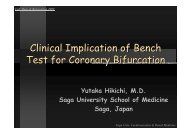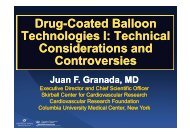In-segment late loss - summitMD.com
In-segment late loss - summitMD.com
In-segment late loss - summitMD.com
Create successful ePaper yourself
Turn your PDF publications into a flip-book with our unique Google optimized e-Paper software.
Basics of<br />
Angiographic <strong>In</strong>terpretation<br />
Analysis of Angiography<br />
Young-Hak Kim, MD, PhD<br />
Cardiac Center, University of Ulsan College of Medicine<br />
Asan Medical Center, Seoul, Korea<br />
CardioVascular Research Foundation<br />
Asan Medical Center
What made us nervous…<br />
Supervisors<br />
Stent<br />
Contrast<br />
Patient care<br />
Catheter<br />
CardioVascular Research Foundation<br />
Asan Medical Center
What we do in angiographic<br />
analysis ?<br />
Qualitative and Quantitative<br />
Measurement of Angiography<br />
taken at preprocedure,<br />
postprocedure and follow-up<br />
CardioVascular Research Foundation<br />
Asan Medical Center
Good Angiography<br />
The first for good analysis and technique dependent<br />
• Angiography is only as good as the quality of the<br />
images taken<br />
• Comprehensive diagnostic - no omissions<br />
• Multiple views - foreshortening and overlap<br />
• Catheter caliber - contrast streaming<br />
• IC Nitroglycerin - vasospasm<br />
CardioVascular Research Foundation<br />
Asan Medical Center
Case Report Form of Angiographic Analysis<br />
in CardioVascular Research Foundation, Seoul<br />
Qualitative<br />
measurement<br />
CardioVascular Research Foundation<br />
Asan Medical Center
Angiography remains a gold standard<br />
• Identifies lesion characters and <strong>com</strong>plications of PCI<br />
• TIMI flow<br />
• Col<strong>late</strong>ral circulation<br />
• Distal embolization<br />
• Vasospasm<br />
• Dissections<br />
• Slow/No reflow<br />
• Perforations<br />
CardioVascular Research Foundation<br />
Asan Medical Center
Angiography: limitations are real<br />
• Thrombus<br />
• Extent of Calcium<br />
• Severity of <strong>In</strong>termediate Lesions<br />
• Unstable/vulnerable plaque<br />
• Bifurcation Lesions<br />
• Can not provides functional data<br />
CardioVascular Research Foundation<br />
Asan Medical Center
Thrombus<br />
Visualization with a Freeze-frame<br />
CardioVascular Research Foundation<br />
Asan Medical Center
• Thrombus<br />
Thrombus and Calcium<br />
Diagnostic Considerations<br />
• Angiography: low sensitivity, high specificity<br />
• Angioscopy is best diagnostic tool<br />
• Calcium<br />
• Angiography: low sensitivity for mild/moderate<br />
Ca, Moderate sensitivity for severe Ca<br />
• IVUS is best diagnostic tool<br />
CardioVascular Research Foundation<br />
Asan Medical Center
Stenosis or Not at Ostial LCX ?<br />
CardioVascular Research Foundation<br />
Asan Medical Center
Case Report Form of Angiographic Analysis<br />
in CardioVascular Research Foundation, Seoul<br />
Quantitative<br />
measurement<br />
CardioVascular Research Foundation<br />
Asan Medical Center
Surrogate End Points<br />
As Quantitative Angiographic Measurements<br />
• Minimal luminal diameter (MLD)<br />
• Late <strong>loss</strong><br />
• Diameter stenosis<br />
• Binary angiographic restenosis<br />
• A reliable substitute for clinical end points in<br />
smaller studies<br />
• To speed up trial progress<br />
CardioVascular Research Foundation<br />
Asan Medical Center
<strong>In</strong>terpo<strong>late</strong>d Reference<br />
standard to assess the degree of stenosis<br />
••MLD = 1.3<br />
• Mean reference: (3.5+2.2) / 2 = 2.85<br />
DS = (2.85-1.3) / 2.85 X 100 = 54.4%<br />
• <strong>In</strong>terpo<strong>late</strong>d reference: 3.2<br />
DS = (3.2-1.3) / 3.2 X 100 = 59.4%<br />
••MLD = 0.5<br />
• Mean reference: (3.5+2.2) / 2 = 2.85<br />
DS = (2.85-0.5) / 2.85 X 100 = 82.5%<br />
• <strong>In</strong>terpo<strong>late</strong>d reference: 2.5<br />
DS = (2.5-0.5) / 2.5 X 100 = 80.0%<br />
4.0<br />
3.5<br />
3.0<br />
2.5<br />
2.0<br />
1.5<br />
1.0<br />
0.5<br />
0<br />
PR Lesion length<br />
DR<br />
Mean<br />
<strong>In</strong>terpo<strong>late</strong>d<br />
CardioVascular Research Foundation<br />
Courtesy of YH Kim<br />
Asan Medical Center
Definition of Late Loss<br />
Post-procedure MLD – F/U MLD<br />
• Within the stent (in-stent)<br />
• Within the analysis <strong>segment</strong> (in-<strong>segment</strong>)<br />
• Within the <strong>segment</strong>, but separately considering the stented<br />
<strong>segment</strong>, proximal and distal edges and taking the maximum<br />
change in MLD within those 3 <strong>segment</strong>s and applying it to this<br />
<strong>segment</strong> as a whole (maximal regional <strong>late</strong> <strong>loss</strong>)<br />
<strong>In</strong>-stent<br />
<strong>In</strong>-<strong>segment</strong><br />
Ellis SG et al. J Am Coll Cardiol 2005;45:1193<br />
CardioVascular Research Foundation<br />
Asan Medical Center
Late Loss<br />
Proximal edge<br />
<strong>In</strong>-stent<br />
Distal edge<br />
Post-procedure<br />
MLD, mm<br />
2.7<br />
3.0<br />
3.1<br />
F/U MLD, mm<br />
2.4<br />
2.2<br />
1.8<br />
Difference, mm<br />
0.3<br />
0.8<br />
1.3<br />
• <strong>In</strong>-stent <strong>late</strong> <strong>loss</strong> : 3.0 – 2.2 = 0.8<br />
• <strong>In</strong>-<strong>segment</strong> <strong>late</strong> <strong>loss</strong> : 2.7 – 1.8 = 0.9 mm<br />
• Maximal regional <strong>late</strong> <strong>loss</strong> : 1.3 mm<br />
CardioVascular Research Foundation<br />
Asan Medical Center
Advantage of Late Loss<br />
• Useful indirect measurement of intimal growth<br />
• No dependency of reference diameter<br />
• Less patients to demonstrate the efficacy of<br />
device than restenosis or clinical out<strong>com</strong>es<br />
CardioVascular Research Foundation<br />
Asan Medical Center
<strong>In</strong>-Segment vs. <strong>In</strong>-Stent<br />
Late Loss<br />
• <strong>In</strong>-stent <strong>late</strong> <strong>loss</strong><br />
- Reflect only the pure biologic potency of an<br />
antirestenotic device<br />
• <strong>In</strong>-<strong>segment</strong> <strong>late</strong> <strong>loss</strong><br />
- Potency of an antirestenotic device<br />
- Effect of margins of stents due to balloon<br />
injury and drug diffusion effects, etc<br />
CardioVascular Research Foundation<br />
Asan Medical Center
Negative Late Loss<br />
What does it mean?<br />
Mauri L et al. Circulation. 2005;111:321<br />
CardioVascular Research Foundation<br />
Asan Medical Center
Potential Limitation of LL<br />
<strong>In</strong>dicating <strong>In</strong>timal Growth<br />
• LL does not indicate the intimal growth at the same site.<br />
• Practically, standard techniques of measuring <strong>late</strong> <strong>loss</strong><br />
have <strong>com</strong>pared MLDs from a specified zone in in-stent,<br />
edge, or in-<strong>segment</strong>.<br />
Location of MLD: distal edge<br />
Location of MLD: mid in-stent<br />
CardioVascular Research Foundation<br />
Asan Medical Center
Measurement Error of LL<br />
due to 2 measures from 2 different angiograms<br />
Post-procedure<br />
Follow-up<br />
• Different guiding catheters: 7Fr vs. 5Fr<br />
• Not same projections<br />
We need • Different well-trained angles personnel, well-developed protocol, and<br />
monitoring • Etc… program in measurement...<br />
CardioVascular Research Foundation<br />
Asan Medical Center
limitations of Bifurcation QCA<br />
Method to determine<br />
the proper reference<br />
diameter for each<br />
individual <strong>segment</strong><br />
The “Step down” phenomenon is a major limitations of<br />
Standard QCA when applied to bifurcation analyses<br />
CardioVascular Research Foundation<br />
Asan Medical Center
What does the <strong>late</strong> <strong>loss</strong> mean in bifurcation ?<br />
Is it the LM, LAD, or LCX ?<br />
mm<br />
4<br />
3<br />
2<br />
1<br />
2.73<br />
BMS<br />
SES<br />
Left main coronary artery stenosis<br />
P
Late <strong>loss</strong> is only meaningful if the<br />
<strong>segment</strong> analyzed is specified<br />
PV<br />
1 – Proximal Edge of the Prox PV Stent<br />
2 – Prox PV Stent<br />
3 – Distal PV Stent*<br />
4 – Distal Edge of the PV Stent<br />
5 – SB Stent*<br />
1<br />
2<br />
9<br />
7<br />
8<br />
5<br />
3<br />
10<br />
6<br />
4<br />
SB<br />
PV<br />
6 – Distal Edge of the SB Stent*<br />
7 – Carina<br />
8 – Ostium of the SB (5mm)<br />
9 – PV <strong>In</strong>-Lesion<br />
10 – SB <strong>In</strong>-Lesion<br />
*if additional stent(s) placed<br />
Gorktekin O et al. Catheter Cardiovasc <strong>In</strong>terv 2007;69:172<br />
CardioVascular Research Foundation<br />
Asan Medical Center
Dedicated Bifurcation QCA Software<br />
CardioVascular Research Foundation<br />
Asan Medical Center
Why do we need Core Lab?<br />
• Scientific support<br />
• Technical support<br />
• Standard guideline<br />
• Research resources<br />
• Training<br />
• Etc.<br />
CardioVascular Research Foundation<br />
Asan Medical Center

















